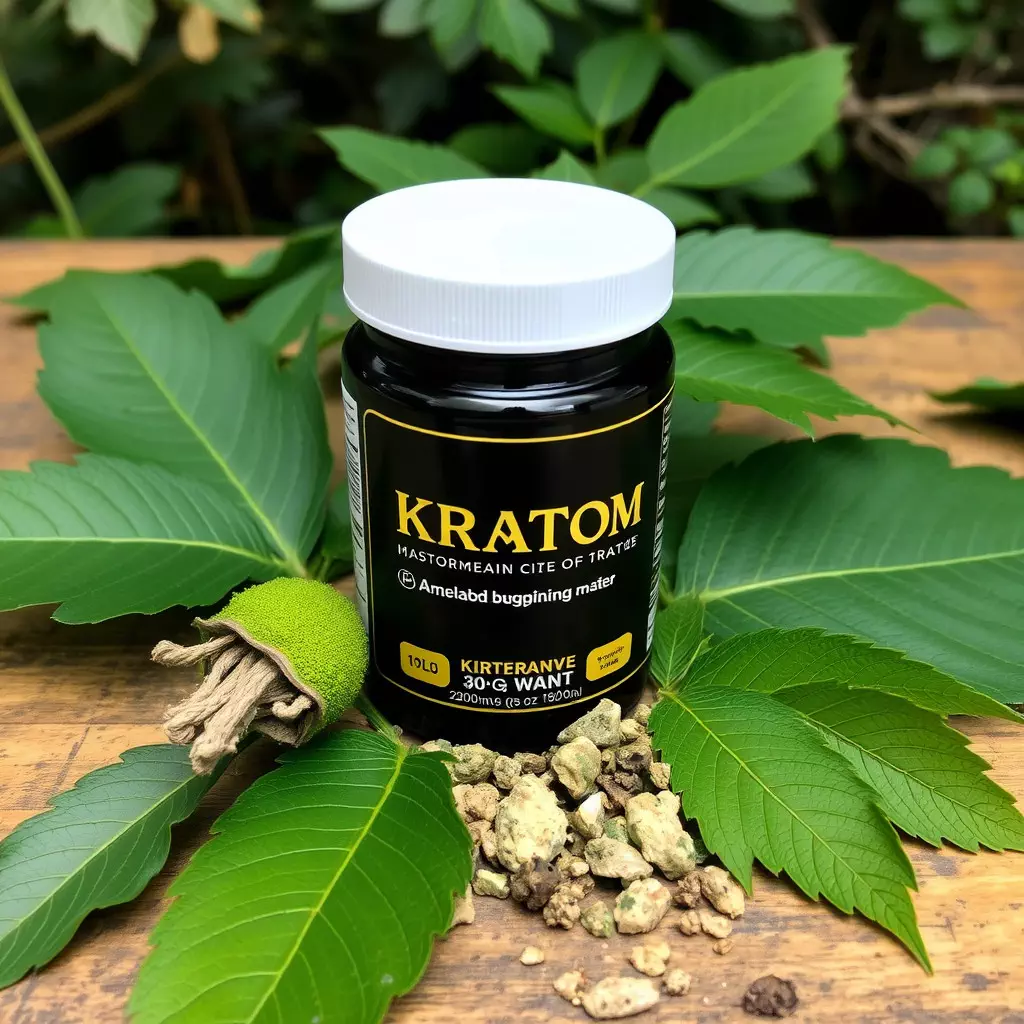Kratom, derived from Southeast Asian plants, is gaining attention as a natural alternative for joint pain relief. Its alkaloids, including mitragynine and 7-hydroxymitragynine, may interact with opioid receptors to manage pain and have shown potential in clinical studies for significant analgesic effects without typical pharmaceutical side effects. Kratom's anti-inflammatory properties could be particularly beneficial for conditions like osteoarthritis and rheumatoid arthritis. However, the scientific community is still researching its therapeutic potential, and users should approach it with caution due to legal complexities and the need for careful dosing and quality control.
Strains such as Maeng Da offer combined energy and painkilling effects, while Bali Kratom may improve sleep quality for those with chronic joint pain. Red vein strains like Red Borneo and Red Thai are known for their potent analgesic properties. Dosage is highly individualized, with a common starting point of 4 to 8 grams, but personal tolerance and the severity of joint discomfort should guide the optimal dosage. Timing of intake can also influence pain relief.
It's important to note that the FDA has flagged kratom for its associated risks, including dependency and overdose, and the American Society of Anesthesiologists has classified it as a high-risk substance for addiction. The legal status of kratom varies by jurisdiction, with some regions imposing bans and others allowing open access. Consumers must stay informed on local laws and ensure product quality and purity. A healthcare provider's guidance is essential before considering kratom as part of a joint pain management strategy, adhering to medical and regulatory standards.
Exploring the intersection of natural remedies and joint health, this article delves into the potential of kratom as a viable option for joint pain relief. We will uncover how different kratom strains and proper dosage can play a role in alleviating discomfort associated with joint issues. Additionally, we will navigate the safety profile and regulatory aspects surrounding its use for pain management. Discover how kratom might offer a unique approach to joint pain relief, backed by insights into its efficacy and legal standing.
- Unraveling the Potential of Kratom for Effective Joint Pain Relief
- Navigating Kratom Strains and Dosages for Optimal Joint Pain Alleviation
- Understanding the Safety Profile and Regulatory Considerations of Using Kratom for Joint Pain Management
Unraveling the Potential of Kratom for Effective Joint Pain Relief

Kratom, a tropical tree native to Southeast Asia, has garnered attention in the realm of natural remedies for joint pain relief. Its leaves contain alkaloids, chiefly mitragynine and 7-hydroxymitragynine, which are believed to interact with opioid receptors in the brain, potentially offering pain-relieving effects. For individuals seeking alternatives to traditional pharmaceuticals, kratom may present a compelling option due to its unique alkaloid profile. Clinical studies have begun to shed light on its efficacy for joint pain relief, with some preliminary research suggesting that kratom can provide significant analgesic benefits without the adverse side effects commonly associated with prescription painkillers. The anti-inflammatory properties attributed to kratom could be particularly advantageous for those suffering from conditions like osteoarthritis and rheumatoid arthritis, where chronic inflammation underpins the pain. As interest in natural and plant-based remedies grows, kratom’s potential as a means for joint pain relief is an area of increasing scientific scrutiny, with ongoing research poised to further unravel its therapeutic possibilities. Users are encouraged to consult healthcare professionals before incorporating kratom into their wellness regimen, especially considering the complex legal status surrounding its use and the importance of dosage and purity in its preparation.
Navigating Kratom Strains and Dosages for Optimal Joint Pain Alleviation

When considering kratom for joint pain relief, it’s crucial to understand the various strains and their unique properties. Kratom, a plant native to Southeast Asia, contains alkaloids that interact with the body’s opioid receptors, potentially offering analgesic effects. For individuals seeking joint pain relief with kratom, the choice of strain can significantly influence the experience. The Maeng Da strain is often favored for its balanced effects, providing both energy and painkilling properties. In contrast, Bali Kratom is known for its sedating qualities, which might be beneficial for those experiencing chronic pain that disrupts sleep. Red vein strains, such as Red Borneo and Red Thai, are also popular among users looking for a potent pain-relieving effect.
Determining the appropriate dosage is equally important when using kratom for joint pain relief. New users should start with a low dose to gauge their body’s response before gradually increasing if necessary. Typically, a moderate dose—ranging from 4 to 8 grams of leaf material—is often recommended as a starting point for pain management. However, individual tolerance and the severity of joint pain will influence the effective dosage. It’s essential to pay close attention to how one’s body reacts, as kratom can affect everyone differently. Users should also consider the timing of their doses, as some may find relief with a lower dose taken more frequently throughout the day, while others might prefer a higher dose administered less often. Always prioritize personal safety by adhering to recommended dosages and consulting with a healthcare provider before integrating kratom into a joint pain management regimen.
Understanding the Safety Profile and Regulatory Considerations of Using Kratom for Joint Pain Management

Kratom, a tropical evergreen tree native to Southeast Asia, has gained attention for its potential in providing joint pain relief. Its leaves contain compounds that may offer analgesic properties, which could be beneficial for those experiencing joint discomfort. When considering kratom for joint pain management, it is crucial to thoroughly understand its safety profile. The U.S. Food and Drug Administration (FDA) has issued warnings about the risks associated with kratom use, including potential dependency, overdose, and significant side effects. Users should be aware that the American Society of Anesthesiologists (ASA) has classified kratom as a substance with high addiction liability.
Moreover, the regulatory landscape for kratom is complex and varies by jurisdiction. While the FDA maintains a strict stance on kratom, classifying it as an opioid, other countries have different legal statuses. In some regions, kratom is fully banned, while in others, it is regulated or available without prescription. It’s important for individuals seeking joint pain relief with kratom to stay informed about local laws and regulations. Consumers should also consider the quality and purity of kratom products, as these factors can significantly impact safety and efficacy. It is advisable to consult with healthcare professionals before incorporating kratom into a joint pain management regimen, to ensure a safe approach to pain relief that aligns with current medical guidelines and regulations.
Kratom has emerged as a potential alternative for joint pain relief, offering a natural approach that merits consideration for those seeking effective management of their discomfort. Careful selection of strains and appropriate dosage are critical factors in optimizing its benefits. It’s important to approach the use of kratom with caution, considering its regulatory status and safety profile. For individuals contemplating joint pain relief with kratom, a well-informed decision, guided by professional advice, is paramount. The article has unveiled the nuances of using kratom for this purpose, emphasizing the importance of balanced insights on its potential and limitations within the context of pain management.






